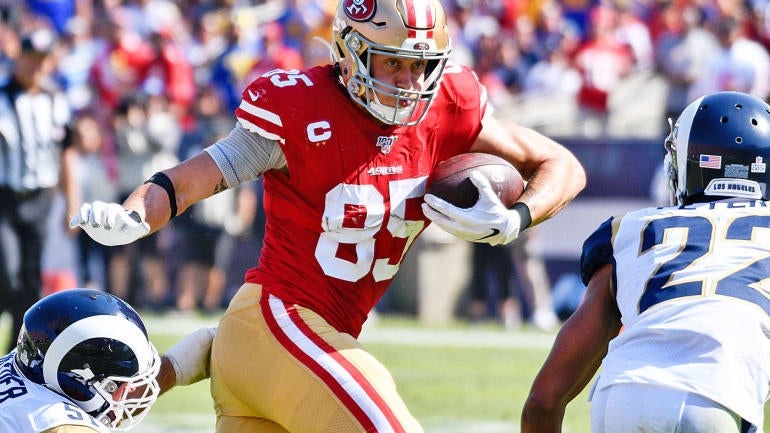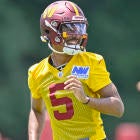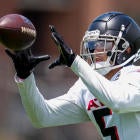
While loaded with high-upside talent, more so than in past years, the tight end position remains top-heavy with four big-time studs. You know which two should get taken between 10th and 30th overall, and you're probably aware of the next two to go between 35th and 50th overall.
A year ago, there was perceived value in the tight ends that were in the tier of tight ends after 50th overall, but one disappointed due to injuries (Evan Engram) and one due to bafflingly poor play (O.J. Howard). This year, that third tier is larger and seems safer because most of the guys in it have proven themselves over some period of time (be it five games or several years).
And the fourth tier after that provides some start-worthy players who might end up crashing the top 10 by the end of the year. Nothing wrong with that, nor is it bad to stream with a tight end from the fifth tier.
TE strategies
The first thing to know is that there seem to be enough players with attractive upside to kind of, sort of deprioritize drafting a tight end. It's not like you'll be forced to pick up tight ends off the waiver wire each week if you don't get one of the tight ends in the first or second tier.
Then again, those four tight ends do have the potential to get at least the equivalent of a top 15 wide receiver from your tight end spot. That's a cool edge to have. The downside is that you'll miss out on a good player at another position by splurging on a tight end by the end of Round 4. Though, if you draft with idiots or are in a smaller league, that shouldn't be as big of a problem.
The second thing to know is that the third tier is thick with top-five upside tight ends -- and they will absolutely be available at a value. You can draft them anywhere from Round 6 through Round 9! If you're not into spending a big draft pick on a tight end, nor do you like taking one off the waiver wire each week, then plan on being a part of the tight end run that'll start after 70th overall and finish by 100th overall. Plenty of time to grab one. It's actually part of a good draft plan because you can load up on rushers and wide receivers early, then nab a tight end you'll consider a reliable starter (fingers crossed!).
| ||||||||||
The tight ends that ranked fifth (Darren Waller, 13.4) through eighth (Hunter Henry, 12.1) in PPR Fantasy points per game last year were within 2.0 points per game of the fourth-ranked one (Zach Ertz, 14.0) and 3.5 points per game of the top-ranked one (Travis Kelce, 15.4). That difference is smaller than the one in 2018 and 2017, which is a possible sign that the tight end position is getting stronger. That's excellent.
Those first three tiers cover nine tight ends, which means most managers in every league will have a good tight end on paper post-draft. We haven't had something like that in Fantasy in a long while.
Are you a loser if you don't get one of them? Honestly, you might be a winner if you wait. The fourth tier is small but it features tight ends who should be in a prominent role in their offenses. Expectations shouldn't be high, but the value can't be beat.
And that takes us to 12 tight ends through four tiers. The rest of the names are considered stream-worthy but could also be Waller-esque values. You may find one or two of them to be so appealing that you'll put them at the end of your bench just to see how they'll fare to start the season.
The bottom line
The talent pool at tight end is better than it's been in the past two years, and maybe ever.
The best values can be found when you can draft a top-four tight end in Round 5, or if you can get one of the next five consensus tight ends (Tyler Higbee, Darren Waller, Hunter Henry, Evan Engram, Rob Gronkowski) as late as Rounds 8 or 9
The intriguing names you'll see late on Draft Day should make you strongly consider putting two tight ends on your typical re-draft roster.
The Fantasy Football Today podcast crew went deep with the tight ends recently. Follow all our podcasts and subscribe here,
Here are the tiers:
T. Kelce
KC
Travis Kelce
KC
|
G. Kittle
SF
George Kittle
SF
|
M. Andrews
BAL
Mark Andrews
BAL
|
T. Higbee
LAR
Tyler Higbee
LAR
|
D. Waller
NYG
Darren Waller
NYG
|
H. Henry
NE
Hunter Henry
NE
|
E. Engram
JAC
Evan Engram
JAC
|
R. Gronkowski
TB
Rob Gronkowski
TB
|
A. Hooper
NE
Austin Hooper
NE
|
H. Hurst
LAC
Hayden Hurst
LAC
|
M. Gesicki
CIN
Mike Gesicki
CIN
|
J. Cook
LAC
Jared Cook
LAC
|
J. Smith
MIA
Jonnu Smith
MIA
|
D. Goedert
PHI
Dallas Goedert
PHI
|
J. Doyle
IND
Jack Doyle
IND
|
D. Goedert
PHI
Dallas Goedert
PHI
|
B. Jarwin
DAL
Blake Jarwin
DAL
|
T. Hockenson
MIN
T.J. Hockenson
MIN
|
I. Thomas
CAR
Ian Thomas
CAR
|
E. Ebron
PIT
Eric Ebron
PIT
|
J. Sternberger
BUF
Jace Sternberger
BUF
|
T. Kelce
KC
Travis Kelce
KC
|
G. Kittle
SF
George Kittle
SF
|
M. Andrews
BAL
Mark Andrews
BAL
|
T. Higbee
LAR
Tyler Higbee
LAR
|
D. Waller
NYG
Darren Waller
NYG
|
H. Henry
NE
Hunter Henry
NE
|
E. Engram
JAC
Evan Engram
JAC
|
R. Gronkowski
TB
Rob Gronkowski
TB
|
A. Hooper
NE
Austin Hooper
NE
|
H. Hurst
LAC
Hayden Hurst
LAC
|
M. Gesicki
CIN
Mike Gesicki
CIN
|
J. Cook
LAC
Jared Cook
LAC
|
J. Smith
MIA
Jonnu Smith
MIA
|
D. Goedert
PHI
Dallas Goedert
PHI
|
B. Jarwin
DAL
Blake Jarwin
DAL
|
T. Hockenson
MIN
T.J. Hockenson
MIN
|
J. Doyle
IND
Jack Doyle
IND
|
E. Ebron
PIT
Eric Ebron
PIT
|
I. Thomas
CAR
Ian Thomas
CAR
|
J. Sternberger
BUF
Jace Sternberger
BUF
|



















